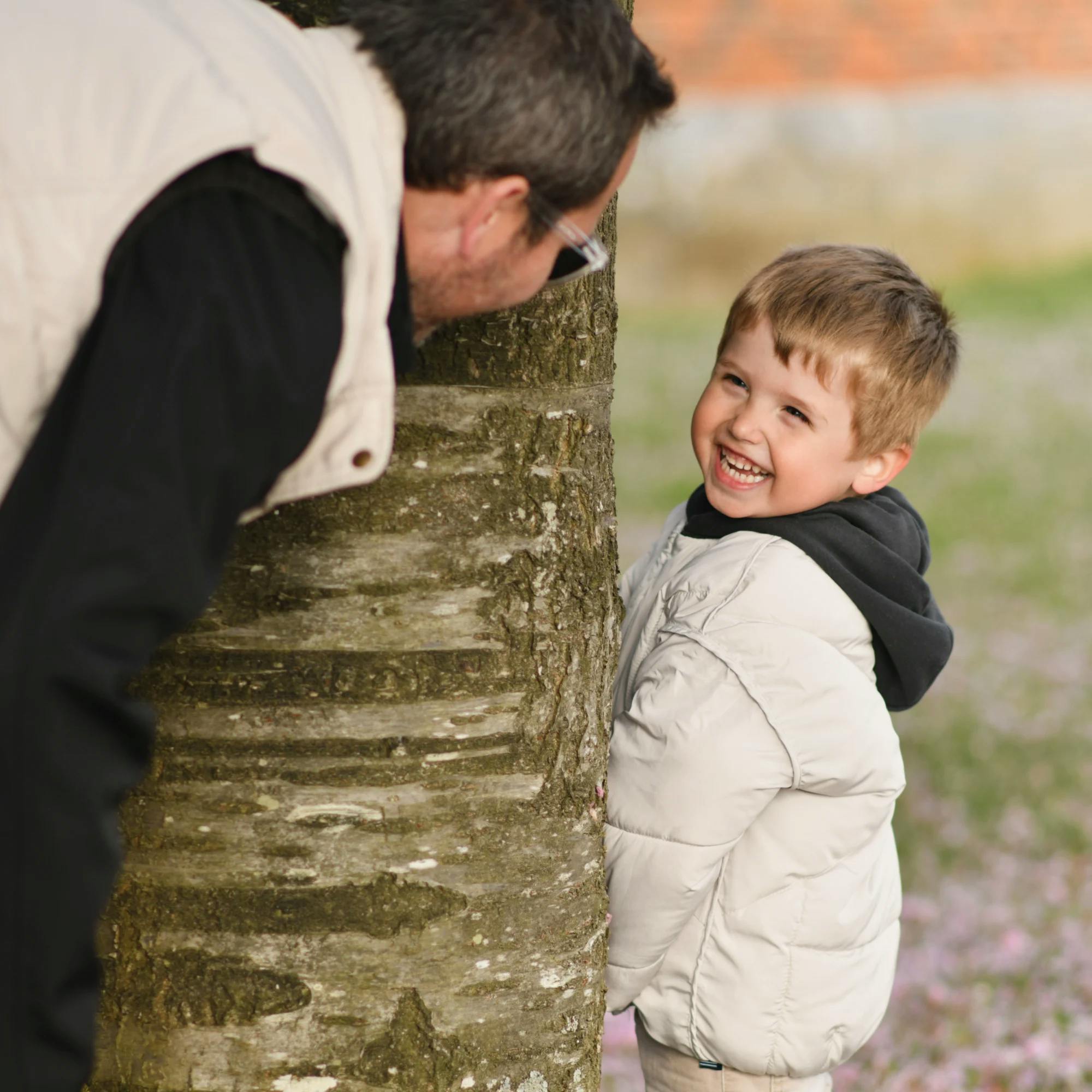
Winter Activities (Indoors and Out!) to Grow Your Child’s Language Skills
 Abby Barnes, M.S., CCC-SLP
Abby Barnes, M.S., CCC-SLP
Growing up, some of my fondest childhood memories were bundling up with my parents and siblings and heading outside for some crisp winter air. If you’re lucky to live in an area that receives snow, what’s better than sledding, snow angels, and snowball fights?
With that said, freezing temperatures and bad weather can mean kids are cooped up indoors, full of energy. But have no fear! There are so many fun and easy winter-themed activities you can do to expand your child’s language skills (and have them blow off some steam!).
Play some indoor winter games
You don't need fancy toys or materials to have fun playing inside. Try these simple activities:
1 Painters tape car race
Take some painters tape and design a race track on the floor for child. Your little one can take their cars and trains and drive them along the course. Don’t worry, the tape will peel right up when you're done!
This is a perfect indoor activity for the two of you to play together, or that toddler can play with older siblings. It also provides lots of opportunities for using words and making fun sounds! Try practicing phrases like “Ready, set, go!” or “Drive the car!” And be sure to incorporate lots of sounds, like “Zoom!” “Beep beep!” and “Vrrrroom!”
2 Musical chairs (or the "snowflake hop")
To play this game, you’ll need several pieces of paper with an action word written on each. Examples could include "jump," "clap your hands," and "stand on one foot." Then, put some chairs in a circle in the middle of the room and place a piece of paper on each chair. As your child’s favorite song is playing, everyone walks around the chairs. However, when the song is paused, everyone runs to a chair and must do the action that’s written on the piece of paper.
3 Balloon volleyball
Dreaming of a warm beach? Your kids can get a jumpstart on summer with just a few balloons. The goal is simple: To hit the balloon up into the air and not let it touch the floor. You can count the number of hits before the balloon touches the ground, then challenge your child to beat that count on the next round. This winter indoor game gets kids up and moving!
4 Cardboard box creations
Anytime you have some delivery boxes, keep them on hand for a bad-weather day. Kids can find so many fun things to do with boxes. It’s the most underrated toy.
You can create a house by cutting and taping boxes together. You can cut out doors or windows, or color them on the outside. Or, your child can sit in the box and pretend it’s a car–they’re in the driver’s seat!
A smaller box can make a garage for toy cars or trains. Take another piece of cardboard and make a ramp. Your toddler can wear boxes, too! Think robot costume or astronaut helmet. Just be sure to cut out the front of the box so your child can see.
Activities like these are perfect for pretend play. This is an important part of play development, and it correlates to speech and language skills. It doesn’t have to be a picture-perfect costume or toy house. Just get creative, have fun, and keep talking with your child while you play!
Is your child on track?
Take our free screener to learn more about your child's development and whether a speech evaluation is recommended.
 Screener for children
Screener for childrenRead children's books about winter
If your child can’t be outside, let’s spark their imagination with a winter-themed book. There’s a ton to choose from, and reading is one of the best ways to stimulate your little one’s language and literacy skills. Here are some of our speech therapists' favorites:
Follow these tips to make the most of reading together with your child:
1 Choose books at the right skill level
If your child isn’t yet speaking, pick picture and rhyming books. If they are reading, make sure that your child knows about 80% of the vocabulary words within the story. If your child is constantly confused by words they don’t recognize or understand, chances are they’ll tune out.
2 Label pictures
For younger children, label the different pictures while you’re reading. Make sure to repeat these words and sounds, and say them slowly to help them stick.
3 Ask "WH" questions
Asking what, where, when, how, and why questions can help build your child’s receptive and expressive language skills. These open-ended questions give your child more chances to think through their answers vs. simple yes-or-no questions.


4 Practice inferencing
For older children, work on predicting and inferencing skills by asking, “What do you think will happen next?”
5 Retell stories
You can help improve your child’s auditory memory by asking them to retell the story you just read in their own words. This is also important for language comprehension to assess how well they retained information.
Play outside
Here are some fun outdoor activities with accompanying techniques to develop your child's language skills. Snow or no, heading outdoors is good for everyone! As the old saying goes, "There is no bad weather, only bad clothing."
1 Build a snowperson
Talk about the steps it takes to build a snowperson or snow angel. This can help your child learn sequencing skills. You might say, “First, I’m going to roll the snow into a ball, next I will make another ball. Then I'll put one ball on top of the other. Last I'll make its face out of rocks and twigs.”
2 Go skating, skiing, or sledding
Before participating, discuss the vocabulary associated with each activity. For example, “What is a chair lift?” or “Show me your skates.”
3 Take a winter walk
Go for a walk with your family. With a baby or toddler, describe the things you see around you. It's OK if your child can't answer you; just hearing you model language helps them learn. If your child is older, talk about what you see together.
This is also a great opportunity to discuss the similarities and differences between seasons. For example, “How is the temperature different?” or “What do the trees look like?”
4 Describe your senses
To build your child’s vocabulary, teach them how to describe what’s happening in the moment. “The snow is crunchy under my feet.” ”Oh, the ground is icy and slippery!” “My nose is cold!”


Have a winter crafts day!
Making crafts with your child is a great way to combine creativity with language learning opportunities. Here are a few ideas to try.
1 Make characters with different materials
Craft snowpeople out of PlayDoh, or use cotton balls and glue. Make sure to use lots of different descriptive words when making your creation, talking about the color, size, shape, and action. You can also make a character out of foods to expose your child to different food textures and discuss both of your likes and dislikes.
2 Draw or color winter animals
Draw or paint different winter animals, like penguins or polar bears. You can also look online for coloring sheets to print out and color. Talk about the different actions these animals do, like swimming and hibernating.
3 Make a shaving cream creation
Make shaving cream snow! All you need is baking soda and shaving cream, mixed up in a bowl. This is a huge hit with kids! As you make it and then play with it, talk about the different ingredients and describe what it feels and looks like.


Prepare a winter-themed snack
Making food together is a tasty way to work on speech skills. Follow your child’s lead by making a snack they love. Discuss the steps involved and describe how the ingredients taste and feel.
I’ve enjoyed making a snowman out of marshmallows, pretzel sticks, icing, and chocolate chips. Yummy! Your kids can help you make hot chocolate, or you might go for the traditional snow-day lunch: grilled cheese and tomato soup. "Cooking" with your child can be as simple as pulling together some ingredients for a trail mix or snack mix: pretzels, dried fruit, nuts, cereal. Let kids get creative with their own invention!
How Expressable Can Help
Concerned your child isn't reaching age-expected milestones? Looking for communication support from a professional? Expressable is a national online speech therapy practice serving children and adults. We treat all major areas of communication and feeding, offer flexible hours including evenings and weekends, and accept most major health insurance plans. We’re proud to have earned more than 3,000 5-star reviews from our clients (4.9/5 average).
Our therapy model is centered on parent and caregiver involvement. Research proves that empowering caregivers to participate in their loved one’s therapy leads to better outcomes. That’s why we combine live, 1-on-1 speech therapy with personalized education and home practice activities for faster progress.
Communication is more than words. It’s how we share how we feel and show who we are. We’re here to help you or your child do just that.








